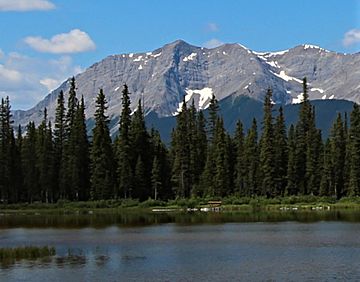Mount Morrison (Alberta) facts for kids
Quick facts for kids Mount Morrison |
|
|---|---|

Mount Morrison seen from Buller Pond
|
|
| Highest point | |
| Elevation | 2,765 m (9,072 ft) |
| Prominence | 133 m (436 ft) |
| Parent peak | Mount Turner (2806 m) |
| Listing | Mountains of Alberta |
| Geography | |
| Location | Alberta, Canada |
| Parent range | Blue Range Canadian Rockies |
| Topo map | NTS 82J/14 |
| Geology | |
| Age of rock | Cambrian |
| Type of rock | Sedimentary rock |
| Climbing | |
| First ascent | 1955 Don K. Morrison |
| Easiest route | Scramble |
Mount Morrison is a tall mountain in Banff National Park, Alberta, Canada. It stands about 2,765 meters (9,072 feet) high. This mountain is part of the Canadian Rockies and is found in the upper Spray River Valley.
You can't see Mount Morrison from most roads in Banff Park. However, you can spot it from Alberta Highway 742, which is also called the Smith-Dorrien/Spray Trail in Kananaskis Country. The closest taller mountain is Mount Turner, located about 1.8 kilometers (1.1 miles) to the north.
Contents
Mountain's Name and First Climb
Mount Morrison was named in 1918 after Sir Edward Whipple Bancroft Morrison (1867–1925). He was a Major General in the Canadian Army during the First World War.
Earlier in his career, he served with Sir Richard Ernest William Turner in the Royal Canadian Dragoons. This was in 1900 during the Second Boer War. It's interesting that Mount Morrison is only two kilometers south of Mount Turner, which is named after his colleague.
The official name for the mountain was accepted in 1924 by the Geographical Names Board of Canada. The first person to climb Mount Morrison was Don Morrison in 1955.
How the Mountain Was Formed
Like most mountains in Banff Park, Mount Morrison is made of sedimentary rock. This type of rock formed from layers of sand, mud, and shells that settled at the bottom of ancient seas. These layers were laid down during the Precambrian to Jurassic periods.
Later, during a time called the Laramide orogeny, these rock layers were pushed up and over younger rocks. This process created the tall mountains we see today.
Weather and Climate
Mount Morrison is located in a subarctic climate zone. This means it has cold, snowy winters and mild summers. Temperatures can drop very low, sometimes below −20 °C (–4 °F), and feel even colder with the wind.
The best time to climb Mount Morrison is usually from June through September, when the weather is more favorable. Water from rain and melting snow on the mountain flows into Currie Creek. This creek then empties into the Spray Lakes Reservoir through the Spray River.
Images for kids




